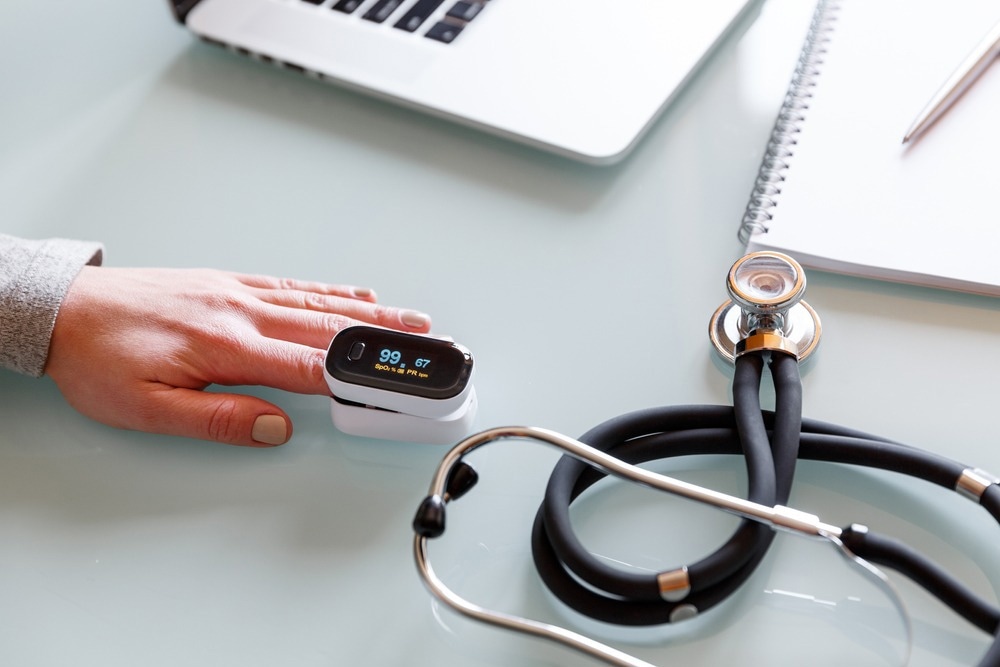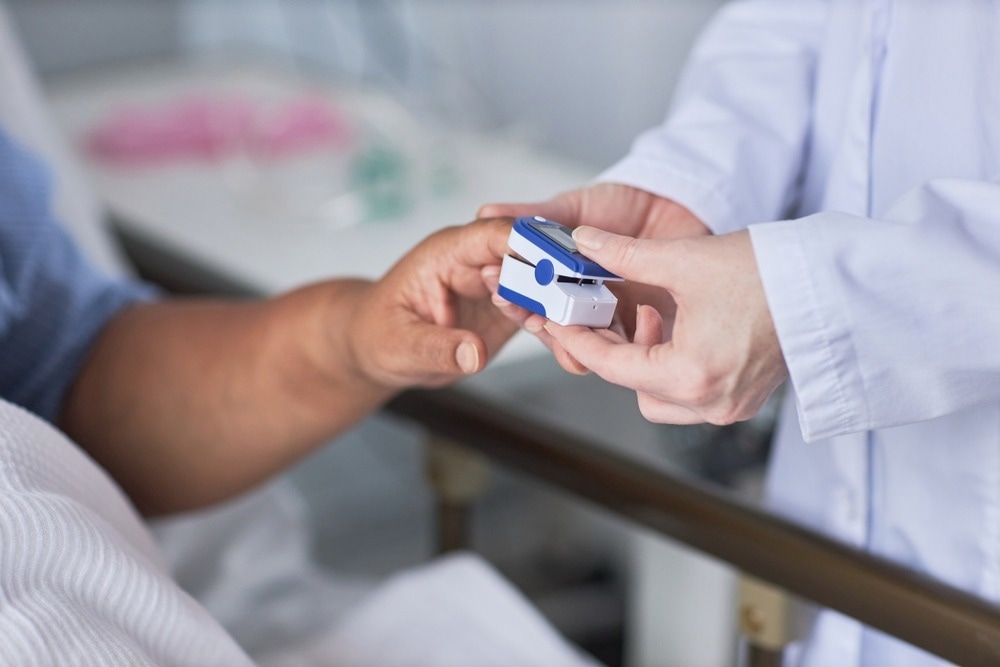Principle of pulse oximeters
Benefits of remote pulse oximeters
Limitations of remote pulse oximeters
Future research outlook of remote pulse oximeters
References
Further reading
A pulse oximeter is a safe, simple, and non-invasive instrument that estimates SpO2, which is the number of hemoglobin molecules in arterial blood that are bound with oxygen. This device has helped identify patients at a high risk of developing respiratory dysfunction due to infection, such as during the COVID-19 period.1

Image Credit: Kartinkin77/Shutterstock.comaac
Principle of pulse oximeters
Dr. Takuo Aoyagi, a Japanese bioengineer, was the first to invent pulse oximetry in 1974.2 The pulse oximeter is based on the light absorption characteristics of hemoglobin at different wavelengths. Photometric techniques are used to detect the differences in the absorption spectra of oxygenated and deoxygenated hemoglobin.3 The advancements in optical and microprocessor technology enabled accurate in vivo measurements in a varied range of conditions.
Modern pulse oximeters are equipped with light-emitting diodes to generate wavelengths of red and near-infrared (NIR) light. These wavelengths are specifically selected because they offer the greatest difference between oxygenated and deoxygenated hemoglobin. The probe, attached to a photodiode, detects the light transmitted or reflected through the tissue.4
The pulse oximeter detects the pattern of light absorbance. Tissue and venous blood cause the maximum light absorbance, while the inflow of arterial blood causes a small amount. For both red and NIR wavelengths, the pulse oximeter estimates the ratio of the pulsatile component to the non-pulsatile components separately.
The ratio of the aforementioned two ratios empirically reflects arterial oxygen saturation. This principle is used to estimate arterial oxygen saturation. Notably, the oximeter reading is mostly independent of tissue thickness, light intensity, and degree of skin pigmentation.5
Normal arterial oxygen saturation ranges from 97% to 99%. Some people, particularly long-term smokers, typically display SpO2 between 93% and 95%. Patients whose readings are less than 90% may require supplemental oxygen and further tests to confirm hypoxia.6
Benefits of remote pulse oximeters
Hypoxaemia is associated with poor respiratory and heart rates. Measuring oxygen content in atrial blood is essential because it provides vital information about pulmonary gas exchange, ventilation, and the patient's acid/base status.8 Pulse oximetry is used to detect hypoxemia.
Remote or virtual care through telemedicine and telehealth has immensely helped to manage patients, particularly at the peak of the COVID-19 pandemic.9 This strategy reduced the risk of exposure to infection from hospital visits. Wearable health devices equipped with pulse oximeters and blood pressure monitors offer continual monitoring of these parameters. These devices provide real-time measurements to healthcare providers remotely to assess patients' health conditions.9
If a remote pulse oximeter indicates low oxygen saturation, it means that the patient requires immediate medical care. Typically, low oxygen saturation is associated with poor clinical outcomes and higher mortality risk. Therefore, during the COVID-19 crisis, clinicians depended on pulse oximeter readings to determine whether a patient required immediate medical attention.10
A pulse oximeter is also used to determine oxygen saturation during exercise, which is a standard component of pulmonary rehabilitation.11 This device is also used to detect sleep-related breathing disorders, particularly obstructive sleep apnoea (OSA). Home overnight pulse oximetry recordings have been used to calculate the oxygen desaturation index (ODI). This estimation reflects the number of desaturation events that occurred per hour of recording. ODI helps understand the degree of OSA.12

Image Credit: SeventyFour/Shutterstock.com
In pregnant women, increased hypoxemia elevates the risk of retinopathy and neurodevelopmental abnormalities in babies. Previous studies have shown that pulse oximetry could be used to improve the detection of congenital heart defects in newborn infants.13
Almost every patient with ventilation or mechanical ventilation requirements benefits from continual monitoring of oxygen levels through remote pulse oximeters. One study showed that remote pulse oximeters helped the timely hospitalization of around 50% of patients who did not show any disease symptoms except a low SpO2.14
Limitations of remote pulse oximeters
An inherent limitation of non-invasive technology is the accurate processing of information received from oximetry. Another limitation is false reading. A pulse oximeter can only function properly if it is able to identify modulation in transmitted light. However, if the perfusion is low, along with a small pulse amplitude, a weak signal is generated that increases the possibility of false reading.15
Some conditions also increase the risk of error in remote pulse oximeters, including poor perfusion due to cold. Furthermore, during cardiac arrest, the peripheral pulses become extremely weak, and the device fails to detect the signal. Reduced tissue blood flow due to vasoconstriction or vasoactive drugs leads to errors in pulse oximeter readings.
Shivering, improperly seated sensors, seizures, or Parkinsonian tremors can cause motion that could interfere with pulse oximeter readings. The device has been observed to work inaccurately in patients diagnosed with bradycardia or those with irregular cardiac rhythms. Furthermore, high-intensity lighting, particularly fluorescent lights, may cause false readings.
Future research outlook of remote pulse oximeters
The COVID-19 pandemic has highlighted the importance of remote pulse oximeters in the public health sector. It has proved to be an effective tool for monitoring deterioration in respiratory health and keeping the patient safe at home. More research is required concerning the affordability of this strategy in a diverse population.15
Not many studies have been conducted regarding the impact of remote pulse oximeters in the healthcare sector. At present, scientists and biomedical engineers are focused on designing remote pulse oximeters catering to the issues of size, accuracy, and power.
References
- Chan ED, Chan MM, Chan MM. Pulse oximetry: Understanding its basic principles facilitates appreciation of its limitations. Respiratory Medicine. 2013; 107(6), 789-799.
- Miyasaka K, Shelley K, Takahashi S, et al. Tribute to Dr. Takuo Aoyagi, inventor of pulse oximetry. J Anesth. 2021;35(5):671-709.
- Torp KD, Modi P, Pollard EJ, Simon LV. Pulse Oximetry. In: StatPearls. Treasure Island (FL): StatPearls
- Cheung A, Tu L, Macnab A, Kwon BK, Shadgan B. Detection of hypoxia by near-infrared spectroscopy and pulse oximetry: a comparative study. J Biomed Opt. 2022;27(7):077001.
- Cabanas AM, Fuentes-Guajardo M, Latorre K, León D, Martín-Escudero P. Skin Pigmentation Influence on Pulse Oximetry Accuracy: A Systematic Review and Bibliometric Analysis. Sensors (Basel). 2022;22(9):3402.
- Vold ML, Aasebø U, Wilsgaard T, Melbye H. Low oxygen saturation and mortality in an adult cohort: the Tromsø study. BMC Pulm Med. 2015;15:9.
- Ascha M, Bhattacharyya A, Ramos JA, Tonelli AR. Pulse Oximetry and Arterial Oxygen Saturation during Cardiopulmonary Exercise Testing. Med Sci Sports Exerc. 2018;50(10):1992-1997.
- Shaver J. The State of Telehealth Before and After the COVID-19 Pandemic. Prim Care. 2022;49(4):517-530.
- Dias D, Paulo Silva Cunha J. Wearable Health Devices-Vital Sign Monitoring, Systems and Technologies. Sensors (Basel). 2018;18(8):2414.
- Shah S, Majmudar K, Stein A, et al. Novel Use of Home Pulse Oximetry Monitoring in COVID-19 Patients Discharged From the Emergency Department Identifies Need for Hospitalization. Acad Emerg Med. 2020;27(8):681-692.
- Iyriboz Y, Powers S, Morrow J, Ayers D, Landry G. Accuracy of pulse oximeters in estimating heart rate at rest and during exercise. Br J Sports Med. 1991;25(3):162-164.
- Varghese L, Rebekah G, N P, Oliver A, Kurien R. Oxygen desaturation index as alternative parameter in screening patients with severe obstructive sleep apnea. Sleep Sci. 2022;15(Spec 1):224-228.
- Singh Y, Chen SE. Impact of pulse oximetry screening to detect congenital heart defects: 5 years' experience in a UK regional neonatal unit. Eur J Pediatr. 2022;181(2):813-821.
- Alboksmaty A, Beaney T, Elkin S, et al. Effectiveness and safety of pulse oximetry in remote patient monitoring of patients with COVID-19: a systematic review. Lancet Digit Health. 2022;4(4):e279-e289.
- Chan, E. D., Chan, M. M., & Chan, M. M. (2013). Pulse oximetry: Understanding its basic principles facilitates appreciation of its limitations. Respiratory Medicine, 107(6), 789-799.
Further Reading
Last Updated: May 14, 2024